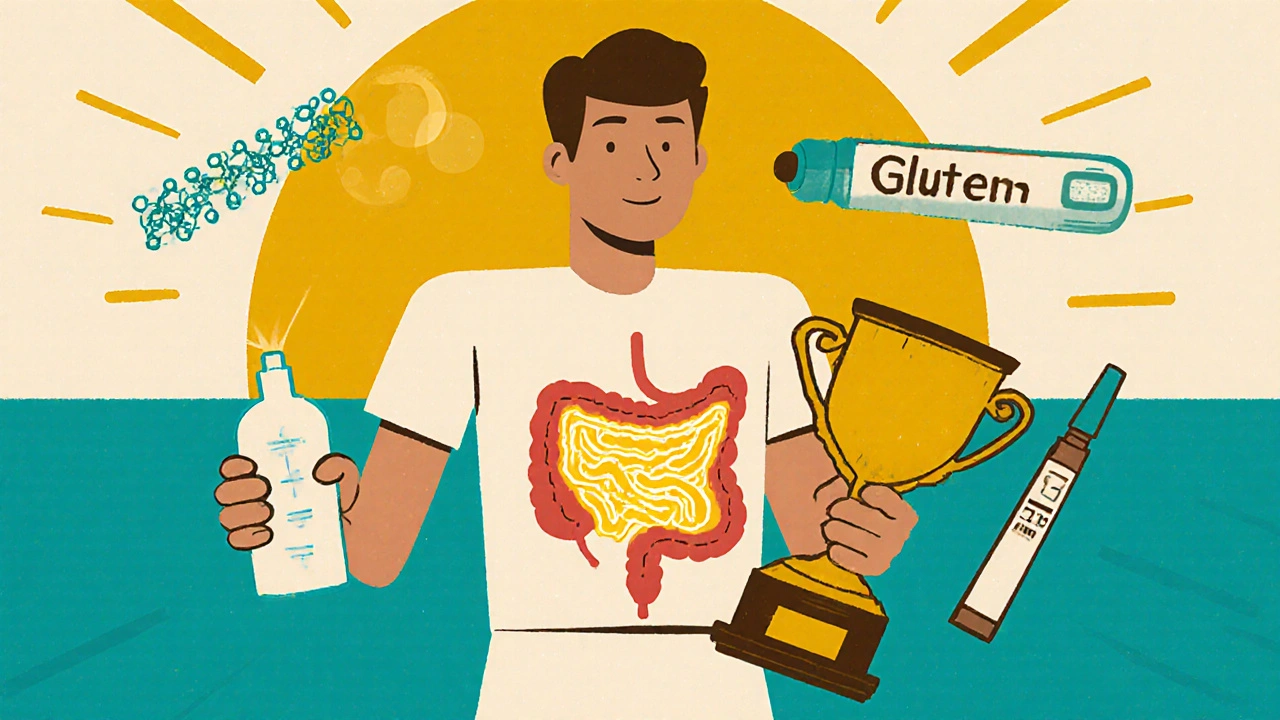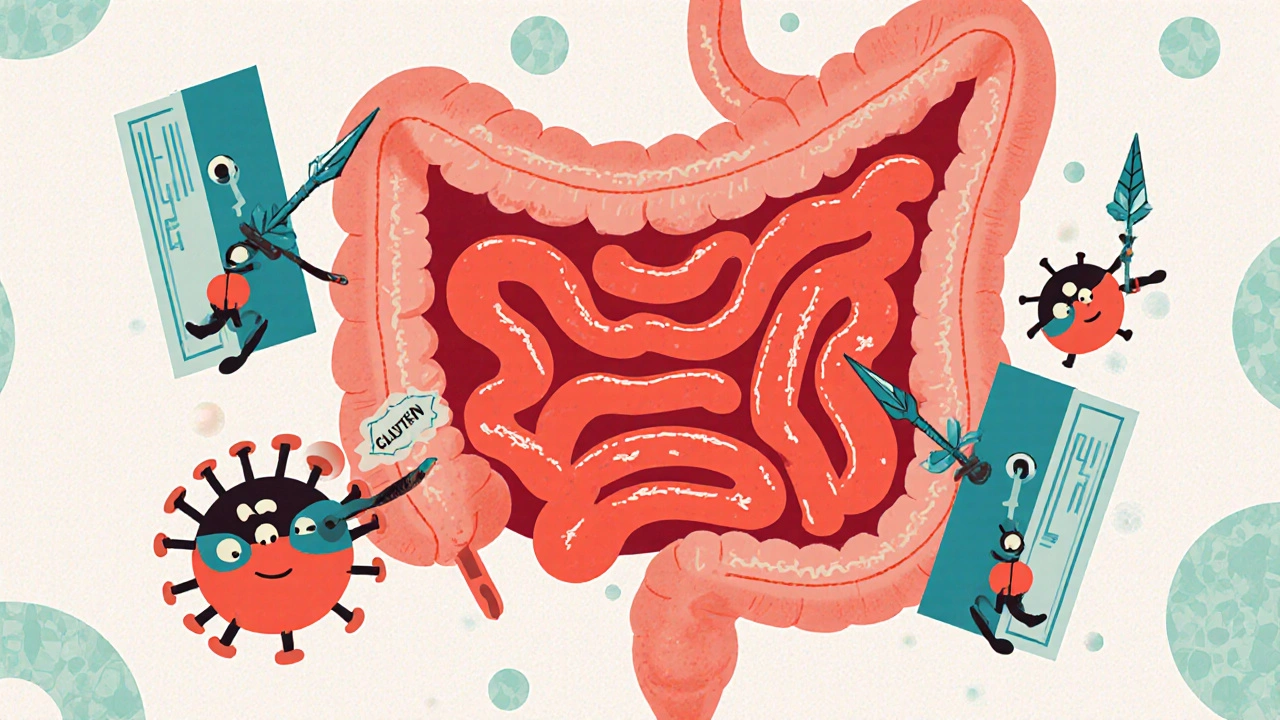When someone with celiac disease eats gluten, their body doesn’t just react badly-it attacks itself. This isn’t a food allergy or a digestive quirk. It’s a full-blown autoimmune response where the immune system mistakes gluten for a threat and turns on the lining of the small intestine. The result? Flattened finger-like projections called villi, poor nutrient absorption, and symptoms ranging from bloating and diarrhea to fatigue, anemia, and even neurological issues. For 1 in 100 people worldwide, this isn’t theoretical-it’s daily life.
What Happens Inside the Body When Gluten Is Eaten
Celiac disease doesn’t start with a stomachache. It starts with a protein. Gluten, found in wheat, barley, and rye, contains fragments like the 33-mer gliadin peptide that resist normal digestion. These fragments slip through the intestinal barrier-not because the gut is "leaky," but because gluten triggers the release of a protein called zonulin, which opens the tight junctions between gut cells. Once inside, tissue transglutaminase 2 (TG2) modifies these gluten pieces, making them more recognizable to the immune system.
People with celiac carry specific genes: HLA-DQ2 or HLA-DQ8. These genes code for molecules on immune cells that grab onto the modified gluten fragments. Once bound, they activate CD4+ T cells, which then release inflammatory signals like interferon-gamma. These signals tell the body to destroy the intestinal lining. The damage shows up as villous atrophy-flattened villi-and increased immune cells in the gut wall. This isn’t temporary irritation. It’s structural damage that takes months or years to heal, even after gluten is removed.
Recent research from McMaster University in August 2024 changed the game. Scientists found that the gut’s own epithelial cells-once thought to be passive bystanders-can actually start the immune response by expressing HLA-DQ2 molecules. This means the gut lining isn’t just a victim; it’s an active participant in triggering the attack. This discovery opens new paths for treatments that target the epithelium, not just the immune system.
Celiac vs. Gluten Sensitivity: The Critical Difference
Not every reaction to gluten is celiac disease. Many people report feeling better on a gluten-free diet without having the autoimmune condition. That’s non-celiac gluten sensitivity (NCGS). But here’s the key: NCGS doesn’t involve the same immune pathways, doesn’t damage the gut lining, and doesn’t show up on blood tests.
Celiac disease has clear diagnostic markers. The gold standard is the anti-tTG antibody test, which is 98% sensitive and 95% specific when the person is still eating gluten. A positive result is usually followed by a biopsy showing Marsh 2 or 3 damage. NCGS has no such test. Diagnosis is made by ruling out celiac and wheat allergy, then seeing if symptoms improve on a gluten-free diet and return when gluten is reintroduced.
Also, the immune response differs. In celiac, IgG3 antibodies dominate, indicating repeated immune activation without tolerance. In NCGS, IgG profiles suggest a different, less aggressive reaction. And while celiac patients must avoid gluten completely-under 20 parts per million (ppm)-some with NCGS can tolerate small amounts without long-term damage.
Dietary Management: More Than Just Avoiding Bread
The only proven treatment for celiac disease is a lifelong, strict gluten-free diet. But it’s not as simple as swapping bread for rice cakes. Gluten hides everywhere: soy sauce, salad dressings, processed meats, medications, supplements, even lipstick and playdough.
Getting started means a full pantry reset. The average cost? $350-$500 to replace everything with certified gluten-free items. You’ll need to learn to read labels for hidden gluten: malt, hydrolyzed vegetable protein, modified food starch, dextrin, and natural flavors. In the U.S., the FDA requires products labeled "gluten-free" to contain less than 20 ppm. In Europe, the same rule applies under Regulation (EU) No 828/2014.
But even certified products can be contaminated. Cross-contact in kitchens is the #1 reason people still feel unwell after going gluten-free. A shared toaster? That’s a risk. A knife used on regular bread? That’s enough to trigger symptoms. Studies show using a separate toaster reduces cross-contamination by 85%. Many people carry gluten-free emergency snacks-92% of experienced patients say this helps avoid dangerous situations.
There’s also a cost barrier. Gluten-free products cost, on average, 242% more than their gluten-containing counterparts. And insurance rarely covers them-only 12% of U.S. health plans do. For many, this financial strain is as exhausting as the diet itself.

What Patients Really Experience
It takes an average of 6.7 years to get diagnosed, according to the Celiac Disease Foundation’s 2023 survey of over 15,000 people. Many are misdiagnosed with IBS, anxiety, or chronic fatigue. One Reddit user said it took seven years and four gastroenterologists before a biopsy confirmed celiac at age 35.
But once diagnosed and gluten-free, most see dramatic improvement. 89% report significant symptom relief within six months. For many, it’s life-changing: brain fog lifts, energy returns, skin clears up. One patient wrote in January 2024 that their follow-up endoscopy showed complete mucosal healing-proof the gut can repair itself.
Still, 42% continue to have occasional symptoms, mostly from hidden gluten. And 58% say the emotional toll is moderate to severe. Social events become minefields. Dining out? 67% report cross-contamination incidents. Young adults avoid parties. Parents worry about school lunches. The isolation is real.
What’s on the Horizon: New Treatments Beyond Diet
While a gluten-free diet works, it’s not perfect. Up to 30% of diagnosed patients still have symptoms despite strict adherence. That’s why researchers are racing to find alternatives.
Three therapies are in late-stage trials:
- Nexvax2: A vaccine-like therapy with gluten peptides designed to desensitize the immune system. Phase 2 results showed a 42% reduction in symptoms.
- Latiglutenase: An enzyme that breaks down gluten in the stomach before it reaches the intestine. In the 2022 CeliAction trial, it improved symptoms by 37%.
- TAK-101: A nanoparticle therapy that trains the immune system to ignore gluten. A 2023 Phase 2 study showed a 63% reduction in intestinal damage.
Other research focuses on gluten-detecting devices-portable sensors that can scan food for gluten at levels as low as 5 ppm. Early prototypes are 95% accurate. There’s also growing interest in the gut microbiome. Studies show celiac patients have distinct bacterial profiles, and tweaking that balance might help reduce inflammation.
None of these are cures yet. But by 2027-2030, combination therapies could mean people don’t need to be as strict. For now, the gluten-free diet remains the only proven tool.

Key Nutrients to Watch For
Years of damaged villi mean many with celiac are deficient before diagnosis. Common deficiencies include:
- Iron: Affects 33% of patients-leads to fatigue and anemia
- Vitamin D: Found in 47% of patients-impacts bone health and immunity
- Calcium: Often low due to poor absorption
- B vitamins (especially B12 and folate)
- Zinc: Critical for healing and immune function
Doctors often recommend blood tests at diagnosis and again after 6-12 months on a gluten-free diet. Supplements may be needed, but always check labels-some vitamins contain gluten fillers.
How to Get Started Right
If you’ve just been diagnosed, here’s what to do next:
- See a registered dietitian who specializes in celiac disease-this is non-negotiable.
- Replace your kitchen tools: get a new toaster, cutting boards, and colander. Clean out all shared containers.
- Learn to read labels. Look for "certified gluten-free" logos (GFCO, NSF).
- Use apps like Find Me Gluten Free to locate safe restaurants.
- Keep emergency snacks in your bag, car, and desk-rice cakes, nuts, fruit, gluten-free protein bars.
- Check medications with your pharmacist. Only 37% of prescription drugs list gluten content.
It takes 3-6 months to get comfortable. Don’t expect perfection. Mistakes happen. The goal is progress, not purity.
Can celiac disease be outgrown?
No. Celiac disease is a lifelong autoimmune condition. Unlike a childhood food allergy, it doesn’t resolve with time. Even if symptoms disappear, the immune system still reacts to gluten. Continuing to eat gluten-even without symptoms-increases the risk of long-term complications like osteoporosis, infertility, and intestinal lymphoma.
Is a gluten-free diet healthy if you don’t have celiac disease?
Not necessarily. Many gluten-free products are highly processed, low in fiber, and lack essential nutrients. Unless you have celiac, NCGS, or a wheat allergy, there’s no proven health benefit to avoiding gluten. In fact, cutting out whole grains may increase your risk of heart disease and type 2 diabetes. Don’t go gluten-free just because it’s trendy.
Can you be tested for celiac disease if you’re already gluten-free?
No. Blood tests and biopsies require active gluten exposure to detect the immune response. If you’ve already removed gluten, results will be falsely negative. To test accurately, you must consume at least one slice of regular bread daily for 6-8 weeks before testing. This is difficult but necessary for a correct diagnosis.
Do oats cause problems for people with celiac disease?
Most people with celiac can safely eat pure, uncontaminated oats. But most commercial oats are processed in facilities that also handle wheat, barley, or rye. Only choose oats labeled "certified gluten-free." Even then, some individuals react to avenin, a protein in oats similar to gluten. Start with small amounts and monitor symptoms.
How long does it take for the gut to heal after going gluten-free?
Children often heal within 3-6 months. Adults may take 1-2 years, and sometimes longer. Healing depends on age, how long the disease went untreated, and strictness of the diet. A follow-up endoscopy after 1-2 years is recommended to confirm mucosal recovery. Some people never fully heal-this may signal ongoing gluten exposure or another condition.
Final Thoughts: It’s a Marathon, Not a Sprint
Celiac disease is complex, but manageable. The science is advancing fast-from understanding how the gut lining triggers the immune response to developing drugs that might one day reduce the burden of a strict diet. But right now, the gluten-free diet is your best tool. It’s not easy. It’s expensive. It’s isolating. But for millions, it’s the difference between constant illness and a full, active life.
Know your triggers. Learn your labels. Build your support system. And remember: healing isn’t just about what you avoid-it’s about what you choose to put back in.


Write a comment